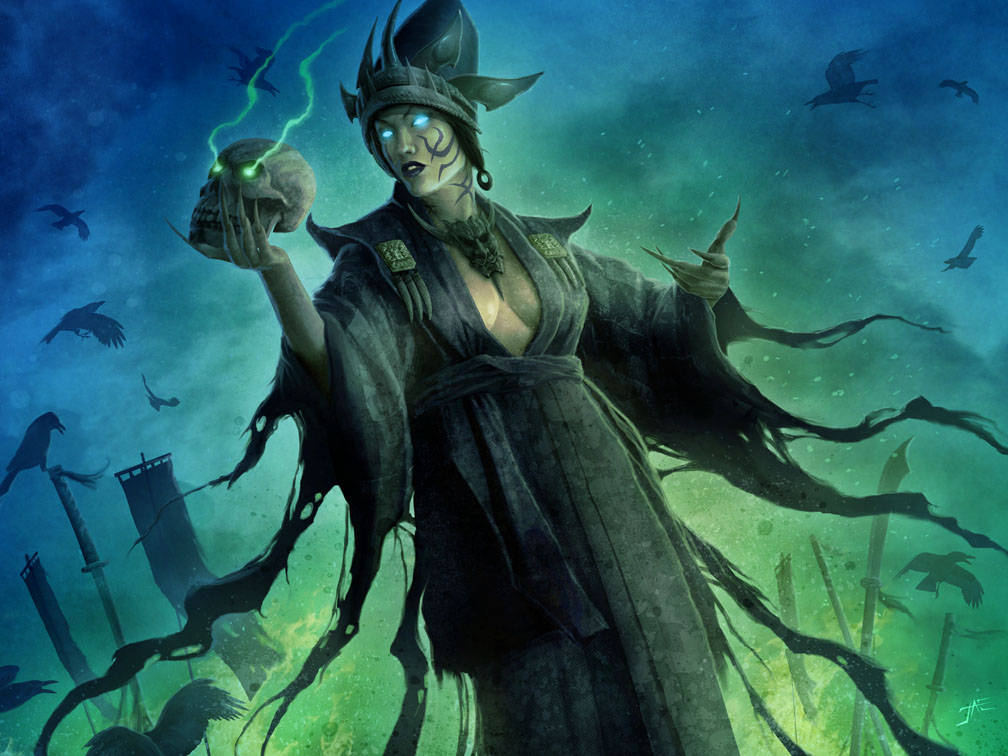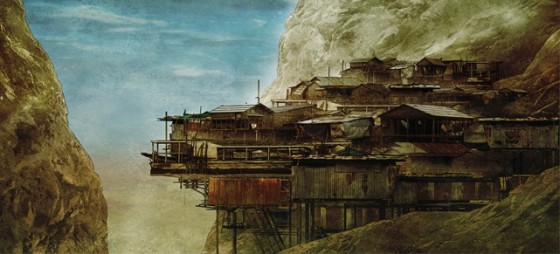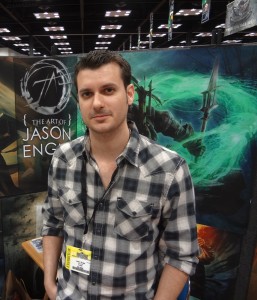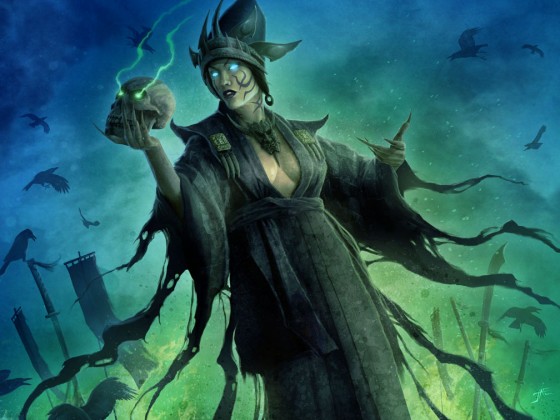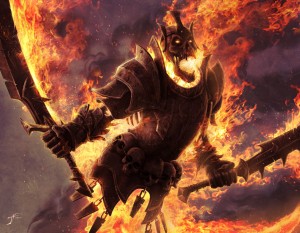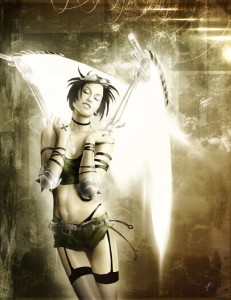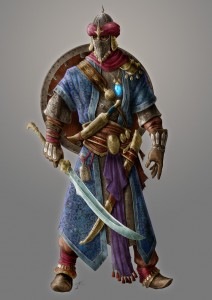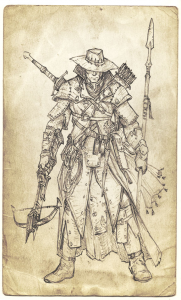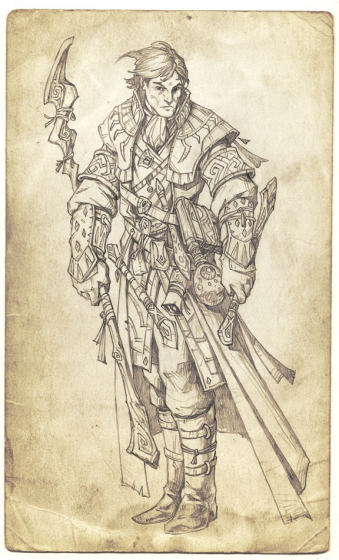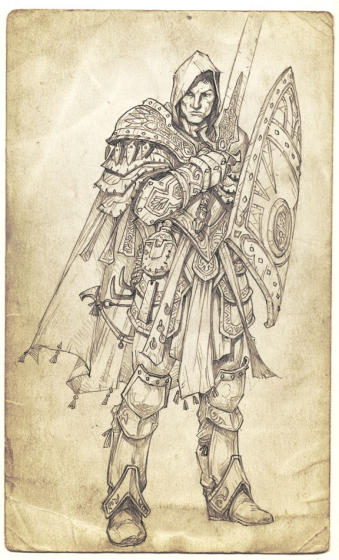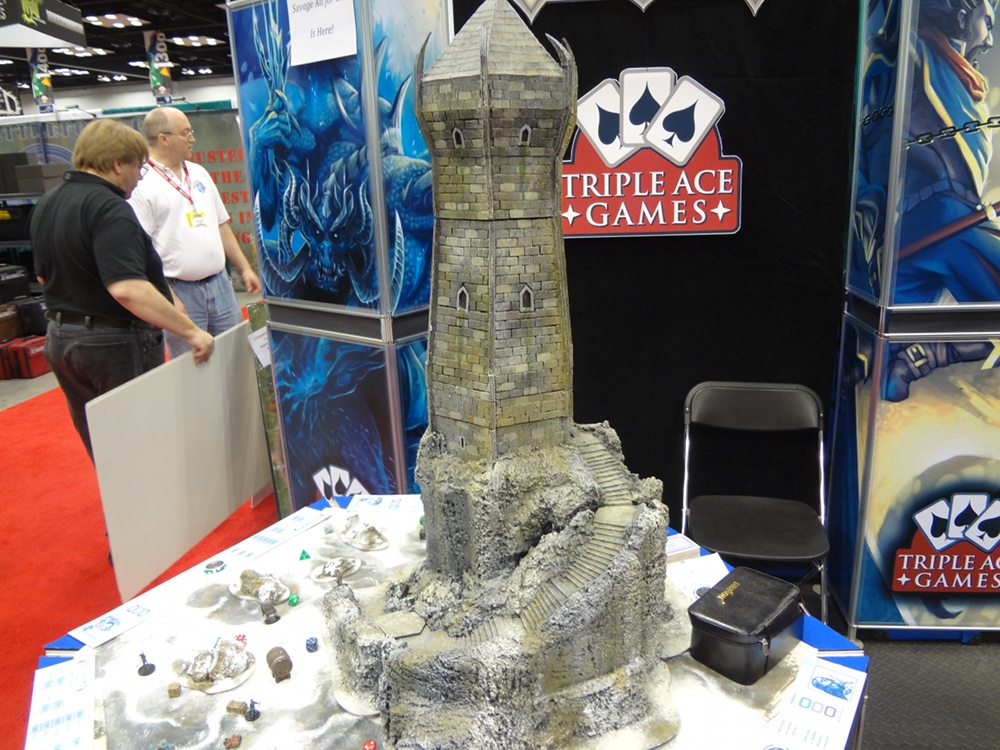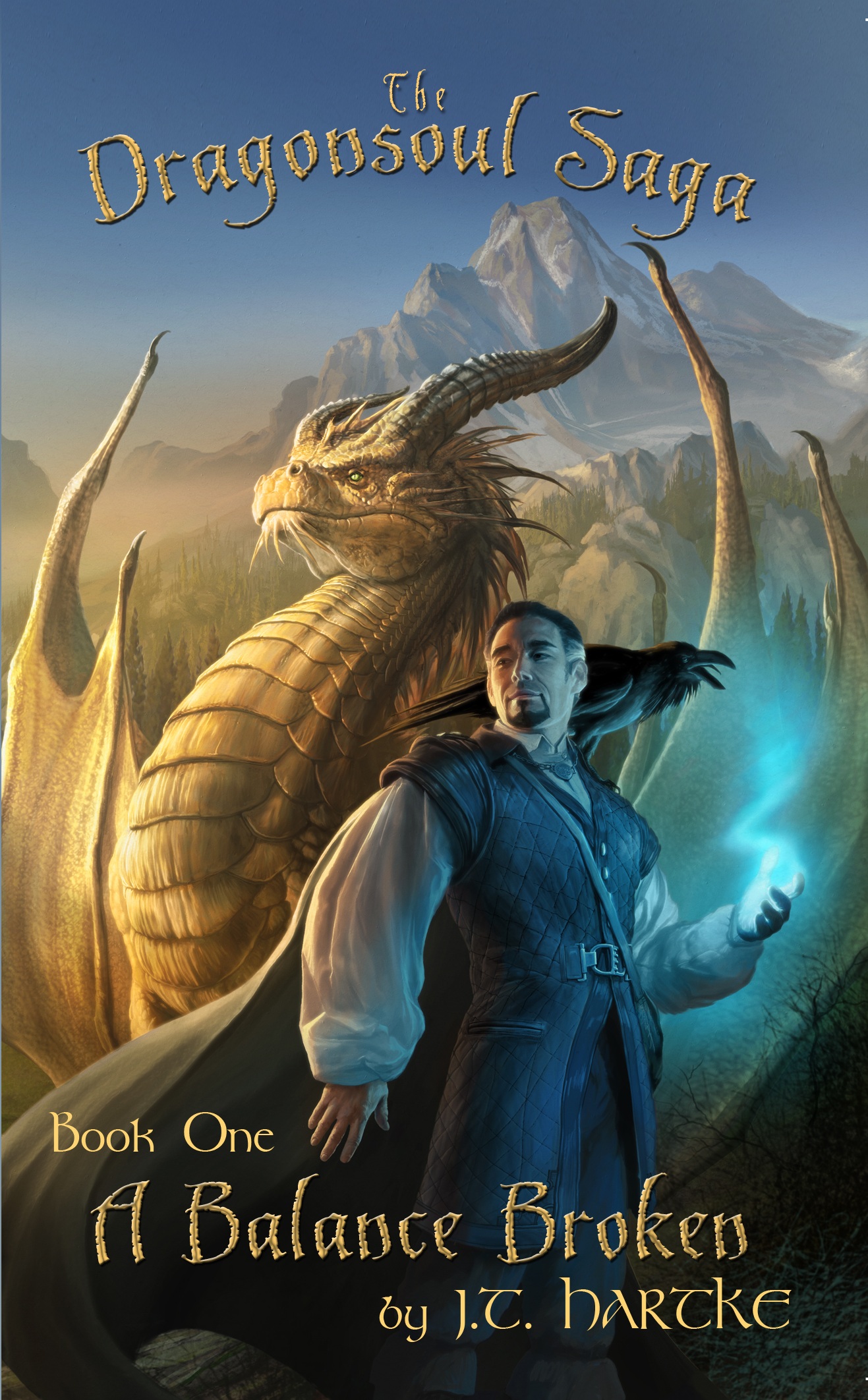Jason Engle on Downfall, Illustration, Pathfinder, L5R and More
Jason Engle is the visual half of the creative team behind the science fiction comic Downfall which finishes its Kickstarter campaign on Friday, October 26. Written by fantasy author Maxwell Alexander Drake, Downfall has strong narrative hooks, striking visuals, and a gripping plot. It also marks a departure for Engle who can usually be found painting fantasy novel covers and illustrations for CCGs and RPGs in Jacksonville, Florida. Engle shared his thoughts on Downfall, illustration, and gaming on October 19. More info on Downfall at downfallthecomic.com and more on Jason Engle at jaestudio.com
Downfall and the Downfall Kickstarter
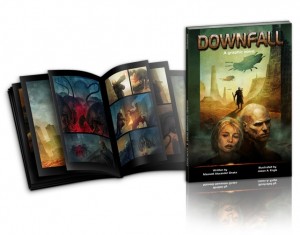 CG: How does drawing for Downfall compare to doing your fantasy art?
CG: How does drawing for Downfall compare to doing your fantasy art?
JE: Well, it kind of doesn’t. That’s one of the things that I like about it. It’s so completely different in pretty much every way. For starters, sequential artwork is fundamentally different from illustration, especially for like card games or role-playing games. You have to think in more storytelling terms. Sometimes they ask to illustrate an RPG and the image may involve a story of one type or another, but it’s more implied and it’s more simplistic. It’s more to illustrate one concept at a time rather than a character throughout a sequence of events in a story like you do in a comic, so it’s very different. I mean the approach is, by itself, something that gives me a lot more interesting challenges than I’m really accustomed to. It’s definitely fun by comparison. It’s a different visual style too. I’m trying to make it more graphic and less painterly, because if I painted every single frame of every page, I might have one issue of the comic done in ten years. So that doesn’t seem like a reasonable production timeline.
CG: Did you go back to any kind of Understanding Comics or anything like that about doing sequential art and refresh your memory of how to do sequential art?
JE: I’ve kind of been dabbling in comics for years. I’ve done a lot of work here and there on a lot of projects that got started that didn’t go very far. [Laughs] I’ve done some work for compilation books, where you just do a small story and it gets included with a bunch of other small stories, stuff like that. I’ve kind of always been into drawing comics in one way or another, so I didn’t really go back and start from square one and go “Gee, what do the experts tell you to do to tell a story?” I kind of already have a handle on all the basic concepts. It has been a lot of fun to put that knowledge to use in a consistent way. It’s been fun. It’s definiely a lot different.
CG: What’s it been like working with Maxwell Alexander Drake?
JE: Absolutely terrible. He doesn’t turn anything in on time, he swears a lot, I can barely get him to pick up the phone, he spends most of his time with drug dealers and prostitutes, as far as I know. Yeah, it’s been good. He’s a fun guy to work with. He’s really, really easy-going. One of the challenges I’ve had getting into comics is that I’ve never really gone after it as a professional objective. It’s never been my main target. Professionally I do very well as a fantasy illustrator. Comics I really enjoy, but I’ve never felt the need to put them first and completely deep six my illustration career. I really like illustration and if comics didn’t work out, I could always go back to it. It’s just not something that I ever really want to put in first place, but one of the problems I’ve had is finding an author who is reliable. And Drake is a novelist. He does a lot of words at a time every single day of his life. He’s very reliable, he’s very professional and he’s production-oriented. When you don’t take comics very, very seriously like I haven’t in the past, you end up partnering with people who also don’t take comics very seriously. [Laughs] When that happens it usually doesn’t go very far. It’s always been a matter of I do a lot of art, I come up with a lot of great ideas and have a lot of fun doing it, and the writing never really gets past one issue. Comics are about quantity. You’ve got to produce a lot of work in a short amount of time. When a comic writer can’t produce a quantity of work reliably, it’s hard to understand but there’s a lot of people who get enthusiastic about a project at the outset and then lose that enthusiasm pretty quickly. It’s one of those things. Some people can be professional creatives and some people can’t. It’s just a matter of whether you can treat it like a job and still have fun doing it. I’ve not had to worry about that with Drake. He already is kind of a self-made, creative professional just the way I am. That’s kind of the great thing about it: we both have the self-drive to do a project on the side and still treat it like a professional goal. It’s worked out really well so far; I’m hoping it continues to.
CG: Now have you read Farmers and Mercenaries or Mortals and Deities?
JE: Yeah, I read both of them! He gave me Farmers and Mercenaries at Gen Con the first year I met him and this was a couple of years ago. He said “Here! Read my book.” And I was like “Sure, guy! I’ll read your book.” But he gave it to me for free so the next year when Gen Con was coming around I was like “Man, I bet I’m going to run into that guy, I should probably read this.” About a month before the convention I picked it up and finished it before I could get on the plane. That way I could meet him at Gen Con and say “Hey! You don’t suck as a writer.” I could actually say that truthfully. When he finished the second book I made sure to get a free copy from him. [Laughs] You know, it was actually better than the first one.
CG: Now you’re waiting just like everyone else for the third, yeah?
JE: Yeah, pretty much. I’m looking forward to it. It’s an interesting fantasy series. It’s got a lot of elements of traditional fantasy in it, but the world he set it in is completely new and original, which is a rarity these days. You know, a lot of fantasy authors try to play it safe and Drake sees very little value in playing it safe and that’s one of the reasons that I wanted to work with him on a comic. When you’re doing a comic, especially fantasy or science fiction, you have to have a certain open attitude to new ideas.
CG: On your promo video for the Kickstarter campaign for Downfall, am I right that you came up with brand new artwork for it? It’s not stuff from Issue 0 or the first series with the scientist?
JE: When we first started talking about doing a Kickstarter video, he started talking to me that he was going to do a script for us and we’d both do like a little webcam thing. He’d say a few lines, then the screen’d split, and I’d say a few lines. It’d be like we were talking to each other, only we weren’t. I was like “Yeah, that could work.” I’d seen a lot of the Kickstarter videos people’d done, it’s all talking heads staring at a camera, saying “This is me. This is my project.” I knew I could do something better than that. I didn’t actually have the technical knowledge to do it, so I went out and found some software and learned how to do a little bit of basic animation. So I threw together a basic concept that was about 30 seconds to a minute long, something like that. It was art that we already had at that point, a logo shot, some music in the background. I was like “Look, here’s more of what I had in mind. It’s more of a TV commercial/video game thing. It’s got a little bit more slow motion drama to it. It doesn’t have to be just us staring at a camera telling people what we’re trying to sell them. Let’s show them the story. I don’t think seeing us ask them for their money is really going to convince people that we have a good idea. Let’s show them the idea.” When he saw that, he got really enthusiastic. He ended up laying in bed thinking about ideas. He got up out of bed and started writing a script. That’s how we ended up with a seven minute video. [Laughs] I’d really only intended for us to have an animated piece maybe a minute long, but he got so into the script he was writing and telling the story about this character. I thought it was such a neat idea, I just didn’t have the heart to shoot it down. In the end, I started out laying out the scenes, doing the animation, and doing the art. I think when I went over the script originally and I wrote down the different ideas of what it needed visually, I estimated probably 30 percent of the art that I ended up doing eventually. It went from being two or three weeks of work to two or three months worth of work.
CG: Yeah, that’s what I was wondering. This isn’t stuff that you’ve recycled, this was all brand new just for the video.
JE: Yeah, it was all custom done. We are going to use it for other purposes. [Laughs] Because we like how the script came out so much we’re going to do a comic version of the video itself and break it into panels and word bubbles and all that because we already have the art and it’s such a neat story. After the Kickstarter’s done, no one’s going to be able to see it really, so we want to put it into print form and make it part of our Issue 0 that we’re doing to catch people up on the background of the story.
Fantasy Artist and Illustrator Jason Engle
CG: Where does card art fit into things versus doing a cover versus interior artwork?
JE: As a freelancer, you take what you get pretty much. You hope you get enough art directors offering you enough jobs to fill up your schedule month to month. There are periods in my career where I’ve done nothing but collectible card games for a couple of years at a time. You get a lot of work doing card games. That’s the great thing about ’em. Some of them pay better than others. Some of them pay really well. Some card games you can only get one or two cards at a time. Other card games, you can get ten or twenty at a time. They usually come out with expansion sets on a pretty consistent basis. If you get your name out there and get prominent and do a few cards that are important in that game then you become one of the face artists of that game and you basically have guaranteed work for the lifespan and popularity of that card game. If you get a few of those on your roster at once then you get a lot of work coming in the door. As a freelancer, that’s a good thing.
CG: Would you consider that to be true for yourself? Were you ever one of these “face” artists for a company?
JE: Uh… yeah. I was the main artist for AEG’s card game Warlord. I was one of the big ones on their game Legend of the Five Rings and I’ve done some promotional stuff for Magic: The Gathering as well. I wouldn’t say that I’m one of their main artists just yet, but they’ve used me a lot on a few of the sets that they’ve done, which is what they tend to do. They have access to so many different artists that they tend to pick a few guys for the different sets that they want to kind of represent and define the look for that set and they use that person much more on that set and then maybe they don’t give them any cards on the next set. I mean they’re a little different from most companies in that they tend to bounce around a lot. But it’s good. They keep a nice, varied look for their game that way.
Warlord is the game that I was the most prominent artist on for a number of years. L5R I’m still one of the more prominent guys on that game. Warlord was a good example back in the day, but it doesn’t exist any more. [Laughs] Yeah, it’s always been great because you go to the conventions and you get to meet a lot of the fans. A lot of the people that go to game conventions these days are people that play collectible card games because it’s a place for them to play in big tournaments and get together and just play nonstop card games for the entire weekend.
CG: Even on that note, the guy behind me on the plane on the way out to Gen Con was and is a huge Warlord fan who’s trying to revive the game, so the chance to meet you would probably be big to him.
JE: It’s got a huge, huge fanbase. It’s one of those games that was sizable enough for a number of years that it still has a number of fans around the world. And a company purchased it, based in Germany, which is where it actually was much more popular ever: in Germany rather than the US. They kept it going for a couple of years. They did their best to kind of revive it, but in the end I think they weren’t quite able to pull it all together and make enough money to keep it around, but there is still quite a fanbase out there for it.
CG: Now when did you really know, I’m going to be an artist?
JE: I never really thought of being anything else, I think. When I was probably four or five years old people would ask, like they do to most kids, “What are you going to do when you grow up?” At the time I didn’t really have an answer. I thought about it for a while and realized I liked art and decided that that’s what I’m going to do. So I started doing that pretty much all the time and then from that point on whenever I was asked that question, I’d say “I’m going to be an artist.”
CG: What was your training once you were out of high school?
JE: My training once I got out of high school was… [laughs] I pretty much went right into a web marketing company rather than going into college or art school. I got a job and I was building websites for a living during the dot-com boom.
CG: So you were doing more graphic design?
JE: Yeah, logos, brochures, websites, anything that people were willing to pay our marketing company to create for them. I mean it was fun. I was able to learn Photoshop and all the wonderful things it could do, but I started applying it to fantasy illustration. When I first started doing it, it took me forever to complete an illustration. Gosh, it was probably two weeks or so to do a single image. All my graphic designer buddies in the office would go “You’re still working on that thing? Photoshop’s not good for that, man, it’s for graphic design. You’re never going to be able to make money doing that. It takes too long.” And now, of course, everyone in the business uses Photoshop to paint, so it turns out that I was just really, really much more correct than they were. It was a fun way to get started.
CG: Are you actually self-taught then?
JE: … Yeah. I kept building my fantasy portfolio and eventually a group of us at the marketing company split off and started our own company which was kind of half-marketing, half web company, and thirty percent game publishing house and I did all the art for that book and all the layout for it and all the graphic design and we launched our RPG book at Gen Con that year. It was callled Shards of the Stone, which is a long title, but it did really well at the convention that year because D&D 3rd edition was also launching. It was like any fantasy RPG that came out that year sold gangbusters even if nobody had ever heard of you. But the advantage of that was that I had done all of the art in that book and it got in front of all the major art directors in that year all at once, so I kind of got my portfolio out there all at the same time. It wasn’t too long after that that I was able to start freelancing full time and leave the graphic design and marketing business behind me.
CG: What’s been your favorite piece of your own fantasy art so far.
JE: Well, I don’t know, man. They’re like kids: you love them all. I would say… Gosh… this is a tough question. Probably The Dark Knight, it’s an image I did for my first art book that I got professionally published back in 2004. I did it for the cover specfically. It’s kind of an homage piece to Frank Frazetta’s Death Dealer. It’s kind of a silhoutted dark knight character on horseback. He’s got spiked armor and looks menacing and all that, but it just-, it’s one of those pieces that seems cliche, but it just came out really well and I was really happy with it and it went on the cover of my first art book so it holds a little nostalgia for me because of that I suppose.
Engle’s Inspirations
CG: Ok, yeah. Who inspires you artistically? Other fantasy and science fiction illustrators? Fine artists?
JE: Anything, yeah. All kinds of fiction and science fiction media is inspiring to me. I get probably more inspiration from other fantasy artists than any other individual source though, but that’s something that I’ve always been a fan of just in general. I grew up with tons and tons of fantasy art books sitting in my closet and on my bookshelves and all around. It’s one of those things where when I got to be part of the business myself, I never really stopped loving the work of other fantasy artists. And now that I know a lot of them, it’s even that much cooler because I still have the books I grew up with and used to copy out of and all the prints that I purchased from them and now I go drink beer with those guys when we go to conventions together. That’s pretty neat.
CG: Is there somebody you’d still like to meet?
JE: Well, gosh, that’s a tough question. I don’t know. I think I’ve gotten to meet just about all my heroes at this point.
CG: So I know Larry Elmore is the kind of guy who would be at Gen Con, so you probably hang out with him?
JE: Yeah, I’ve hung out with Larry a number of times. He still has no idea of who I am. He’d probably know me by face and not my name. That’s one thing you start to realize: some of these guys that have been in the business for 30 or 40 years, they’ve met so many people over that period of time that they get to know people visually more than they get to know you by your actual first name. But no, I’ve spent time hanging out with pretty much all of them. I’ve hung out with Brom and Michael Weylan and Todd Lockwood, Larry Elmore and yeah, you name any of the big name guys in the business and I’ve at least shook their hand.
CG: Yeah, you’ve named two of my favorite artists, Brom and Elmore.
JE: Oh yeah. No, those were probably two of my biggest influences growing up. I think Elmore for a long time and Keith Parkinson were my two major influences when I was younger. As I started getting a little older, Brom started to become more prominent on the scene and as soon as I started to see more and more of his stuff I instantly just loved him more than anybody else.
Engle’s Speed as an Illustrator
CG: Changing topics just a little bit, how long did something like Spirit of the Burning Sky take?
JE: Um… well, it really depends honestly. If a piece is really really complex it could take a few days. But if it’s just a single character, it really isn’t that bad, I mean that particular image, took me maybe four or five hours.
CG: Wow. Ok, so you’re very quick?
JE: I mean yeah, that’s always been one of my advantages in the freelance business, especially when I was starting out. I had a lot of art directors that would come to me for last-minute, emergency jobs. If another artist dropped out or when they needed a huge amount of work in a very small amount of time, I’m quick enough that they could come to me and say “Hey, can you do me a favor? Can you do me a rush job?” And I can say “Yeah, absolutely.” So I kind of always built myself that way and developed my style around both quality and speed.
CG: You work now just purely in Photoshop?
JE: A lot of the time, yeah. I do still like to sketch things out in advance. I do thumbnails and work out the compositions. I do a bit of a tighter sketch. I usually do several of those and send them in to get approved. And when those get approved, I just pick the one that works and start painting the rest in Photoshop, but I still do like to do everything in pencil first if I can, if I have time. It just allows you to play around with a lot more ideas and kind of niggle around details. Photoshop’s great for painting, but it’s one of those things that some people can use it for sketching. For me it doesn’t quite have the same organic feel that real pencil has.
CG: And you’ve tried tablets and things like that?
JE: [Laughs] I have them all, man. I’ve spent I don’t even know how much money on equipment that’s sitting in my closet. It’s all about the process that works best for you. The shortest amount of difference between your imagination and the finished image is always going to leave the better stuff. If a tablet works really well for you and it feels really natural and easy and you don’t even notice it’s there, by all means go for it, but I’ve never played with it enough to where it’s gotten to that point for me. It’s easier for me to use pencil and a piece of paper and then I use a mouse from that point forward.
CG: Have you kept track of how many separate pieces of art that you’re at?
JE: Oh god! I don’t have any idea. I’ve done a lot of games where I’ve been the only guy producing work on that game and you know when that happens, you’ve done or you do hundreds of pieces of art. And you know, I’ve been working on the L5R card game since, gosh, almost since the start of my career, so what? Probably twelve, thirteen years. And when you’ve worked on a card game that long there’s no telling how many pieces you’ve done for it all in total. So I’ve probably done over 10,000 pieces.
CG: Oh wow. How old are you now?
JE: I’m about to turn 32. I started when I was 18. You start early, it gets you a lot more time. I was hanging out with Todd Lockwood at Comic-Con this year and he was like “So how long have you been at this anyway, I’ve seen your stuff for years.” And I was like “About 14 years.” And he was like “14 years! You don’t even look 14!” But you know, you get started early it gives you a lot of time to build up your portfolio. Art’s one of those things that really doesn’t require a college degree to be more successful. It’s more a matter of skill. Portfolio, man. If you’ve got the ability to do it, it doesn’t matter if you spent four years in school.
CG: Well are you involved in anything any more where an art director hasn’t heard of you or you need to prove anything?
JE: Oh sure! You pretty much always have to, I mean, there’s sides of the business I haven’t spent much time in, like comics for example. Probably almost every art director in the comic business hasn’t heard of me unless they’re into fantasy games specifically or read fantasy novels. They probably have no idea of who I am so if I ever do comic work as a freelance gig, that’s somewhere where I really have to prove myself. Novels, it’s the same way. Every time I’ve worked on a video game it’s the same way, these guys don’t really know who you are, they don’t really know how long you’ve been around, and honestly they tend not to care. On the higher end of the pay scale, the art directors know that they’re paying for the absolute best of the best. That’s pretty much what you’ve got to bring to the table. It doesn’t matter how long you’ve been at it, it’s just a matter of what you can do. So you never really stop having to prove yourself in that way.
On Art Direction
CG: Does art direction vary much from gaming company to gaming company?
JE: Oh, absolutely. It’s definitely different. And it’s not neccessarily every gaming company so much as every art director. Different art directors have different styles of dealing with freelancers and some know how to do it better than others and some are very controlling in the way they want to do it and those are usually the ones I prefer not to work with, because they’ll be intentionally vague at the outset, let you do a lot of work, and then basically tell you to change it all because you didn’t do it the way that they were hoping you would do it telepathically. [Laughs] That’s usually not something I like to deal with very long because simply put, when you’re a freelancer time is money. When one art director wants to cost you twice as much as time or three times as much time as other art directors do for what boils down to the same amount of paying work, that’s not a job that I really have a lot of enjoyment for.
“If you get a compliment for the work you’ve turned in that’s three words word or longer then that means that you just blew it out of the water! It means that they’re probably going to use that piece for promotional purposes and stuff like that.”
– Jason Engle
So yeah, I mean they definitely differ. Every art director’s different. You know like the art director for Magic: The Gathering for example. He will give you a job and it will have a few paragraphs of detailed description and a style guide which is usally over a hundred pages long with lots of reference art in it. Then once he gives you that, that’s usually the last you hear from him. [Laughs] I mean usually you turn in the final art and you get a one word answer when you turn it in, where he goes “Awesome.” or “Good.” He’s pretty hands off when it comes to art directing. He hires people that he knows can do the job and doesn’t worry about it and he’s one of the best art directors in the business.
CG: Were you being literal about the awesome vs. good?
JE: [Laughs] We like to joke about him because he has these one word responses to almost everybody. If you get a compliment for the work you’ve turned in that’s three words word or longer then that means that you just blew it out of the water! It means that they’re probably going to use that piece for promotional purposes and stuff like that. Yeah, most art directors I’d be exagerrating but with Jeremy [Cranford] it’s literal, yeah. But it’s because he has to art direct so many pieces of art all at the same time. It’s unbelievable how much art Magic puts out and how many different expansions they work on at the same time. It’s pretty nuts. He does what he needs to for time but it also means that it kind of decomplicates the issue for the rest of us. Some art directors will give you a response to an image and have you do little fixes or little changes here or there. And if he sees something that needs to be changed, he’ll definitely let you know, but honestly most of the time if it looks good and it works, that’s what he cares about. And that kind of frees an artist really. You don’t feel as concerned about doing the job and getting every little detail to be just the way the art director wants it. You just try to do the job as well as you can. It’s a purely pscyhological approach. It gets all the BS out of the way.
CG: You have a work, Soma, it seems like it was drawn from life or a photo, was it? You usually work from your own sketches though?
JE: Yeah, that one was actually drawn from reference. That was a piece for a website that basically had a competition. They had a promotional character that they had a bunch of artists do different versions of and that was actually from well back in my career. I did that piece probably nine or ten years ago at least. But the time frame on it was so short and it wasn’t really a paying gig, I was doing it as a favor to the guy who ran this site, so I needed to streamline the process a little, so rather than making it a really actiony/illustratish you have the drawn image. But I went and found a good bit of reference photography and kind of pieced it together and then I painted it from there and really streamlined the process, it kind of ended up giving it a different style and a different look, which I like, but it also took a lot less time than just noodling around until the lighting gets right and all of that. Having a reference is great; it really streamlines it. If you’re working on the kind of project where they want something that’s photorealistic or just realistic, it’s a great way to go.
CG: For all your other work just in general though you’re working from sketches?
JE: I’d say about 80-90 percent of it. It’s just a matter of doing work for the client based on what their visual style is, based on the brand and the product. Everything has to have a different look. If you’re a working artist, you’re creating art for a brand. They’re a lot of guys that have their own signature style, stick to that, and won’t do anything outside of it, and yeah, I have kind of a signature style, but I’m capabale of doing a lot of different styles and I enjoy doing a lot of different styles. That’s another reason that I enjoy working on Downfall so much, because it requires that I come up with a totally new style from anything I’d done before.
CG: You can see that visually that it is different, just like you can see that Paizo illustrations are kind of different than other fantasy art.
JE: Yeah and Paizo is another good example. I tried to draw a little bit more in the style of the main artist they had used on their Pathfinder game in the past and stick close to their visual brand that way. I’ve done the same thing with D&D and a number of the RPG’s I’ve worked on.
Jason Engle’s Cartography
CG: Another one of the things that you’ve done for a bunch of gaming companies is you’ve done cartography, so is that a nice break from illustration for you?
JE: Oh yeah. Like I said, I like to do different styles. When it comes to doing a different style, there is no different style that is more different than cartography. It uses a totally different side of your brain almost. It’s a lot of fun. It’s a little bit more relaxing. With illustration you kind of build it up, piece by piece as you go. Sometimes it can be a struggle, sometimes the pieces don’t fit together the way you thought they would, but you don’t know that until you’re already haflway through the image. It can really really kind of devolve into a fistfight with the image. But with cartography that never happens. It’s so straightforward and so simple that it’s just a matter of putting all the pieces into place, making it clear and making it look good on top of that. And if you can do all that, then you can do cartography and it’s a lot of fun. Because I’m also an illustrator it’s given me the ability to do different kinds of cartography from what a lot of the guys working today can do. I can do cartography that’s more illustrative, that’s a little bit closer in, that’s more attuned and actually has an illustrative element. That’s why Wizards of the Coast used me for a lot of the battle maps that they’ve done, their Dungeon Tiles product line, their Fantastic Locations product line. They just came out with a new board game called Dungeon Command where I did all the board pieces for that. It means I kind of straddle both sides of the business, but I love them both equally so it’s a good way to get out of your comfort zone.
CG: Do you have any tips for GMs at home making their own maps on ways to improve?
JE: My biggest tip is learn Photoshop, because once you learn that, you’re not as limited in as many ways. I used to make maps when I was a kid playing Dungeons & Dragons and I used to get my hands on as much graph paper as I could find and it worked for what I needed to do, but today if you’ve got a copy of Photoshop, there’s really no limit to what you can put together in terms of a map. And the tools are so powerful that you could make something that’s very very concise very easily and very quickly.
The Gaming Side of Jason Engle
CG: So for gaming, you just actually mentioned it, when did you start gaming?
JE: I’m not even really sure what the age was, I think it was eight or nine. It’s a pretty normal story as far as that goes. I had a friend that got really into gaming and started telling me about it. He got me and my brother into it. We just pretty much loved the hobby from that point forward. That was the time that I was kind of building my illustrative skill so I was able to use gaming as a way to grow those skills. There’s a lot of times where you’re sitting around the role-playing games table where you want to draw your character or you want to draw someone else’s character or you find a cool sword and you want to draw what that looks like. So it gave me an excuse to build my skill set.
“…when people would ask me what I was going to do, I wouldn’t just say I was going to be an artist, I’d say I was going to be an artist that worked for TSR.”
– Jason Engle
CG: Did you start on D&D then?
JE: Uh, I did, I did. I moved on from there to Role Master and RIFTS and Shadowrun. I’ve played most of the big ones from one time or another. In the end I’ve always come back to D&D. That was the game that after I started getting into it and after I started getting good at drawing, when people would ask me what I was going to do, I wouldn’t just say I was going to be an artist, I’d say I was going to be an artist that worked for TSR.
CG: Ok. Yeah. Awesome.
JE: It turned out to be not as accurate.
CG: So you grew up admiring the Elmore illustrations in the Player’s Handbook.
JE: Oh yeah. I’d say one of the pivotal moments for me was right when I was getting into role-playing games I got a copy of a Dragonlance artbook. It was basically, I think, the first one that they’d done, the Art of the Dragonlance Saga. It kind of introduced me to a lot of the artists that I’d seen their work, but didn’t know them by name and it introduced me to a lot of that stuff in quantity and I was able to just pour over all the art. I just wore the pages of that book out looking at the art day after day. That’s one of the reasons that I fell in love with so much of the art in the gaming business and kind of why I drove my skills in that direction.
CG: Now are you still gaming today?
JE: I do, I do! [Laughs] When I have time! I would say I manage to get a game in probably every month or three. It’s not something that I manage to do all the time. And all the guys I game with now are all my age or a few years older and they’ve all got kids. Everybody’s schedules don’t always work together easily enough to get together for a six or eight hour session, but when we can, we absolutely make it a priority to do it. And I don’t play D&D anymore, I play Pathfinder, but that’s basically the same thing.
CG: So you’re playing on Game Mastery map packs right, that you helped to illustrate?
JE: Yeah, I do. The guys like to make fun of me when they spot something like a little mistake or could be a softer shade. They like to needle me about that kind of stuff. Usually when you do work on a game for one of the bigger companies they give you a complimentary copy of the product which means that we basically never have to buy anything, because I work on so many different games I get tons of free books. Honestly, I try to keep one copy for myself for my book shelf at home, but if they give me three copies of something I just show up to the game table and go “Here, guys! I got some free stuff.”
CG: You’re a couple of years younger than me, but this is all stuff that we would have loved to have growing up, the Map Packs…
JE: Absolutely. It’s all stuff that’s really taken the game and made it so much more visual. It just really makes the game more three-dimensional in a number of ways. Even as a kid I used to use miniatures, but it was always kind of challenging. You had to use a lot of your imagination and it didn’t always work all that well. The fact that they started introducing that as the main component of the rules set, building visual products to go along with it, I mean it’s really improved the game immeasurably in my opinion, not just because I work on it.
CG: Even there, how are you as a miniature painter?
JE: Oh, I’m terrible. [Laughs] I try not to get into the actual real life paint if I can avoid it. It’s a very very time consuming process. For some reason when I’m working on a two-dimensional piece of art that’s original and I’ve spent all that time and effort in creating myself, I can spend ten hours at a time doing it. But when I’m painting someone else’s sculpture I just have very little patience. It’s not a hobby that I was ever able to really get into.
CG: So, it doesn’t translate?
JE: Yeah, you’d think it would, but for some reason it doesn’t click for me. But thankfully I have a number of friends that are very into it. I let them do all my miniatures painting for me and I draw their characters for them.
Collectible Card Games
“The sad reality is that I used to play Magic and after I got old enough to have disposable income I was able to stop playing Magic and get in a recovery program and kick the habit.”
– Jason Engle
CG: Going back not to RPGs, but to card games, did you play L5R or still play it?
JE: I’ve never played a single game of L5R. [Laughs] I should lie about that or I should go out and start playing it, one of the two, but I’ve never actually gotten to play a game of it. The sad reality is that I used to play Magic and after I got old enough to have disposable income I was able to stop playing Magic and get in a recovery program and kick the habit. I haven’t gone back into that area since with collectible card games because I know they’re something that I absolutely love and will sink a lot of time and money into if given the opportunity, so I try to keep myself from getting back into the hobby. Because I know I would love L5R if I started playing it like that and I’d be playing it all the time. It’s a wonderful game from what I understand. I know lots of people in the community. Like I said, I’ve been working on it for so many years that I’ve had the chance to meet most of the players that are really big in the community at the conventions and I got to say that L5R is different from a lot of the games out there in that players are so tight knit and they’re so nice, which sounds weird to say. But like, for example, you go to one of the Magic tournament and they’re very different in mind set because it is a broader scope of playerbase. There’s a lot more people that are more mainstream and less into the whole geek hobby which means it’s a lot more competitive, a lot more aggressive mindset. It’s not a very tight knit community in that sense, whereas L5R a lot of the people know each other. It’s just more of a real community of players which is kind of neat and unique in my experience.
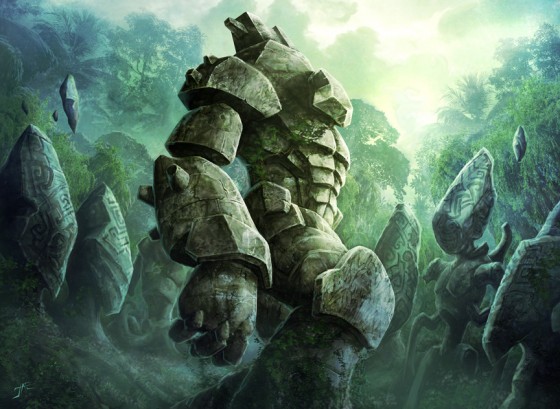
Engle’s Magic: TG Card Art for Ominous Statuary. Prints available at buyfantasyart.com
Board Games
CG: And what about any board games, you delve into that a little bit or are you more of an RPG guy?
JE: Yeah, I’ve done a couple of board games. I did Thunderstone. I did all of the art for that one. That came out a couple of years ago and I think it’s gosh, I don’t know how many expansions they’re on now, but it’s done pretty well. The first board game I did was called Tobogans of Doom. Yeah, that one you’re probably not going to find on too many shelves.
CG: And I was just actually asking if you’re a player of board games, haha. Wasn’t expecting that you’d done some.
JE: Well, I used to. I haven’t really been into too many of those for a few years either. The things about board games in particular is that they’re sort of similar to card games in that you have to be around a certain amount of the gaming community in order to get introduced to new ones and have people to play them with and all of that and I just don’t really go to that many gaming stores these days. There really aren’t that many in Jacksonville that are worth going to visit. The sad truth is that they’re kind of a dying breed and even ones that do have a bustling community built around them, if you don’t know where they’re located in your town, you’re pretty much out of luck. If there was a play to do that sort of thing in Jacksonville, I’d be absolutely into it. I do still enjoy board games when I get the chance to play. But without a real community to be a part of, it’s not something I spend a lot of time doing.
More on Engle’s RPGs
CG: So when you’re playing RPGs like Pathfinder now, are you the player or the GM?
JE: I’m a player. I’m a total player. I’ve dabbled at GMing. It’s fun to do, but here’s the problem with someone who’s overly developed their visual aesthetic: when you start designing an adventure, you start designing everything from a more visual standpoint than you need to and you end up spending way too much time in all the wrong areas. And when it comes time to play the game all that preparation work is generally not all that useful, so it’s a great thing to do, it’s really enjoyable, but GMing just takes too much time for me to really put into it. But I love playing and it allows me to both play my character and draw scenes from whatever is going on at the time. And the other players don’t mind having that so it works out.
CG: My last question for you then is what kind of characters do you end up playing?
JE: Um, well I’ve played them all, man. [Laughs] I’ve played the giant barbarian, the thief that usually ends up getting blown up first, I’ve even done the cleric, you know the healer, because no one else wants to play it. I usually like the fighter characters more to be honest because yeah, when you’re playing a combat game – which is what D&D and Pathfinder essentially are – your main skill set is going to be much more useful as that kind of character. Even though the guys I play with, we’re a little older, we try to integrate a lot more story and a lot more role-playing into our game, but in the end when your character’s really going to be bested and all the chips are down, it doesn’t hurt to have a fex extra hit dice.
